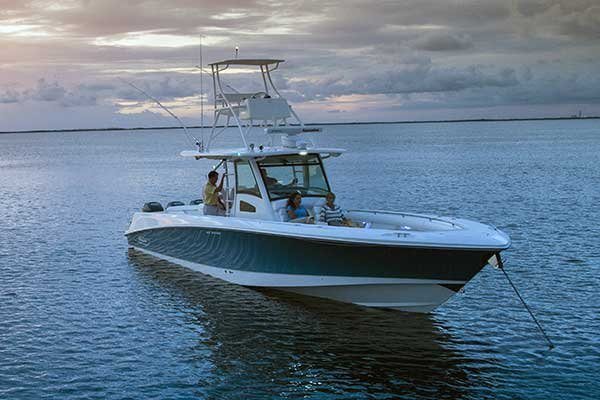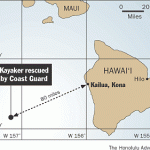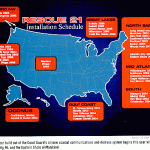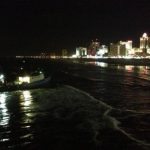In the years I’ve been sailing, I’ve witnessed countless anchoring antics: There was the Caribbean bare-boater who heaved a spaghetti jumble of hook, line and chain over the bow, then jumped into the dinghy and disappeared ashore while the yacht drifted irresolutely out to sea. And the weekend warrior who showed up in a popular Biscayne Bay hideaway with no anchor aboard at all! It’s amazing how few sailors really know how to anchor their boats well.
Anchoring poorly endangers not only the skipper’s own boat, but every other vessel in the harbor. Even if your anchor does usually hold, take a moment now to review these practical pointers – tips on how to anchor under power so that, come hell or high water, your boat will stay where you put it.
Ground tackle – anchors, chain, line and shackles – needs to be of a size suitable to the vessel. As a rough guideline for sailboats of moderate size and displacement, the primary bow anchor ought to weigh at least 1-lb. per foot of length on deck. Bigger is better. One additional anchor, made up and ready with its rode attached, should also be carried aboard. A third, even a fourth anchor is standard equipment aboard boats that cruise. An anchor needs to have some sturdy galvanized chain between it and the anchor line, no less than 15 or 20 ft. Again, more is better. Most experienced cruising sailors fit one of their bow anchors with an all chain rode, often using a windlass with a chain gypsy to handle it.
As you near an anchorage, check to see that the anchors you plan to use are ready to be lowered, that the rodes will run free, and that the bitter ends are fastened to the vessel. If you’re towing a dinghy astern shorten up on the painter enough so that it can’t possibly reach the propeller when you’re backing down.
Explain to your crewmembers what’s expected of them, assigning duties and deck positions as necessary. It’s a good idea to establish a few simple hand signals (see illustrations) so that the helmsman and the anchor handler can communicate without shouting back and forth to each other over the whine of the wind and the engine. Depending on who’s calling the shots, the helmsman may need to communicate the commands to “let go (or retrieve) the anchor”, “feed out more scope”, and “snub or cleat off the anchor rode”. The anchor handler needs signals to request forward, neutral, and reverse gears, as well as higher or lower Rpm’s. One husband-wife team I know even has a signal for “calm down, dear!”
Once inside the harbor, you’ll first want to consider how the boats already there are anchored. Typically, many boats will be swinging to a single anchor rode. But some or all of the boats may have two anchors set off the bow, or one off the bow and one set astern. Some may be riding on permanent moorings. When the wind or current shifts, the vessel with two bow anchors set will swing in a shorter radius than boats on a single anchor. Vessels anchored fore and aft won’t swing at all. Those on permanent moorings will pivot around their bows, but move very little. In very light airs, boats with all chain rodes may not swing as far nor as quickly as those riding to a mostly nylon rode. You, as the newest arrival, must anchor to keep clear of vessels already there, positioning your boat and your anchors to allow for any change in wind direction and strength. This often means imitating the anchor arrangement of your neighbors, or else keeping far enough away to allow room for a different anchor plan. Bear this in mind when you select your place among the fleet. It’s always safer to leave extra space around your boat.
Now, position your boat bow to the wind (or the current, if that’s the stronger force), right about where you want to end up once you’re anchored, roughly equidistant from your nearest neighbors. Check the depth to be sure you’ll have ample water beneath you at dead low tide. Next, motor slowly ahead a distance of about 7-times the water depth reading you just took. Here, take a new depth sounding, and then add to that the anticipated rise to full high tide. Use this new number to calculate how much scope you’ll be using:
A safe minimum anchor rode length in normal weather conditions is a 7 to 1 (rode length to depth) ratio, or 5 to 1 for an all chain rode. “Depth” in this case is the actual depth of the water at high tide, plus the height of the anchor hawser above the water’s surface. (Scope = [water depth + hawser height] X 7). So if high water is 20 ft. deep, and your bow roller is 5 ft. above the water, you’ll need to use at least 175 ft. (25 ft. X 7) of line-plus-chain anchor rode to anchor. It’s a good idea to have your anchor rodes marked off in ten- or twenty-foot increments to facilitate reading rode length as you feed it out. If you anticipate a blow, a ten to one scope isn’t too much to pay out. To the extent that harbor space permits, the heavy weather rule is the more scope the better! Remember that putting out too little scope is one of the most common mistakes skippers make when anchoring. Later, they wonder why their boat dragged up onto a lee shore during a squall!
While still hovering above the spot where you intend to lower the anchor, take another look around your boat. Don’t set your anchor close alongside or close off the bows of another vessel. If you do and the wind shifts, you may well swing into him, or he into you. In either case, you’ll be responsible for any damage caused, being the last to have anchored. It is usually safe, however, to set an anchor close astern of another boat, or close off his quarter. Look, also, at where the rodes of nearby boats are pointing. A boat may have a second anchor set off in your direction, which you could foul if you drop yours on top. If the harbor winds are very light and variable, don’t assume that everyone’s anchor is positioned straight out in front of them. In calm conditions, anchor rodes – especially chains – may be stretched out in any direction, towards wherever the last real breeze blew from. If in doubt, ask any skippers you see aboard nearby boats where their anchors lie.
If everything appears to be all right, circle back around to your intended final resting spot and then slowly coast forward approximately the distance of your planned scope. Here, stop the vessel completely with a short burst of reverse power. Wait until your vessel has lost all way, coming to a complete halt before lowering the anchor. Do not drop the hook while the boat still has any forward way on. If you do, your anchor chain will drag over the anchor when the boat drops back and it may foul the anchor.
When you let go the anchor, don’t allow the chain and rode to run screaming out of the chain locker to pile on top. Rather, lower the anchor quickly but with control, paying out the rode through gloved hands, or hand over hand, until you feel the anchor rest on the bottom. As you begin lowering the anchor, the helmsman can shift the engine into idle reverse, so that the vessel just begins making slight sternway about the time the anchor reaches the bottom. (If it’s windy, leave the engine in neutral and let the boat’s windage provide the backing propulsion). As the boat continues to back slowly, feed out the anchor rode by hand, maintaining a slight tension on it, so that it is laying out straight on the bottom, rather than piling up. Keep the boat’s reversing speed to a bare minimum, the engine just ticking over.
Once you have fed out about one-third to one-half of the scope with the boat still backing slowly, tighten your grip on the rode until you feel the slack taken up and the anchor tugging. Then let the line feed out a bit more, keeping a light tension on it so that the anchor is being set straight. Again, tighten your grip enough to feel the anchor tug. If your grip isn’t strong enough for this, pass the line under the horn of a deck cleat to make it easier to hold. Snub up firmly, but not long enough to drag the anchor along on the bottom. Just long enough to feel it tugging for a second; then ease off. Repeat this snub-and-feed pattern several times. On a larger vessel with an all chain rode and heavier ground tackle, it may be necessary to use the windlass gypsy for this, alternately braking and releasing the drum.
This gentle snubbing and feeding of the rode while backing down the boat is the surest way I know to make an anchor set, even in difficult holding grounds. Yet it is a technique that very few sailors seem to appreciate. It gives the anchor an opportunity to right itself, penetrate the bottom surface, and dig in gradually. It also keeps the rode clear of most bottom debris and it helps keep the vessel’s bow from falling off the wind. Usually, even before the scope is completely paid out, you can feel that the anchor has set.
When you’ve laid out the prescribed amount of scope, make fast the rode while the boat is still reversing at idle speed. If the hook has taken hold, the boat will come up short on the rode and come to an abrupt halt, firmly setting the anchor. You’ll feel the vessel stop backing and, in a moment, spring forward slightly on the rode. But there’s still one more step to being certain you’re securely anchored.
Select a range directly abeam of you, two stationary objects, preferably ashore, which are some distance apart but more or less lined up: a dock piling with a building beyond; a pair of trees – whatever’s handy. Now put the engine in reverse, giving it a few hundred Rpm’s above idle speed. Keeping your eye on the range abeam, you’ll see by its movement that the boat is beginning to make sternway as the rode stretches out. If the anchor is truly set, the boat will come to an unmistakable, abrupt halt as soon as the rode is taught. The range points will verify this by ceasing to move in relation to each other. Still watching the range, increase the reverse throttle a bit more, ensuring that the anchor will indeed hold under stress. Ease up on the throttle and let the engine idle in reverse a moment before shifting into neutral. This allows the anchor rode to relax without it springing the boat forward. A cautious skipper will now repeat this back-down maneuver at least one more time before cutting the engine.
If, however, the range continues to shift while you’re backing down, then the anchor is dragging. If the hook drags more than a few yards without setting, you’ll have to retrieve it and repeat the entire anchoring sequence. In harbors with rocky or grassy beds where the water is clear enough to see, it pays to visually locate clear patches on the bottom into which an anchor can be lowered to set more readily. But no matter how good your technique, some bottoms are simply poor holding and may require repeated attempts to set a hook. Occasionally, you may bring up the anchor to discover that it has fouled itself in an old car tire, beach towel or paint can in which case it never would have set nor held the boat.
In clear water where the bottom is visible, it’s smart to take a look at your anchor even after you feel it is set. Following your own rode from the ship’s bow, swim or dinghy over the anchor and look at it through a face mask or a glass-bottom bucket. If you’re a strong swimmer, you can dive down and hand set a partially set hook by physically jamming the point into the bottom. Afterwards, observe it from the surface while your crew backs down with the ship’s auxiliary engine. You’ll see the anchor dig itself in deeper. This is absolutely the most foolproof method there is to ensure an anchor is set.
If, because of restricted harbor space, you have to anchor with slightly less than optimal scope, you can enhance the holding power of your ground tackle by weighing down the anchor rode. This calls for a sizeable lead weight to be shackled to the rode of the anchor after it’s already set, so that the lead can slide down the line to the harbor bottom. Tether the weight with a retrieving line so you can control how far it travels, and so that you can pull it back up before weighing anchor. With this lead in place on or near the harbor floor, the boat tugging on the anchor rode must overcome and lift the weight before putting any significant pulling force on the anchor itself. Even then, the initial angle of pull will be more nearly horizontal, which is what you’d have accomplished had you been able to use more scope. This technique is no replacement for adequate scope in winds strong enough to straighten the weighted rode, but it may be useful for a short stopover in a crowded harbor in settled weather.
If there’s a possibility of inclement weather or of a wind shift that would swing the boat into danger, then setting a second bow anchor is called for. Many prudent skippers always set two anchors as a matter of course. This doesn’t mean you have to get into the dinghy and row out to windward with an anchor and a pile of chain – something I’ve seen done all too often. Instead, simply determine where you want the second anchor to be and drive the ship over there. You’ll probably have to temporarily pay out extra line on your first anchor to do this, and take it back in once the second hook is set. Place the second anchor at an angle of 45 to 60 off the first, or else in the direction of the most likely or most threatening wind shift. Set it using the same snub-and-feed technique described above.
Placing a stern anchor, when it’s called for, can be done by paying out and, afterwards, retrieving lots of extra bow anchor rode, or by carrying out the stern hook in the dinghy, whichever seems easier.
Anchoring a boat securely is among the most basic and most important of boating skills. Learn to do it right – with technique, control and confidence – and we’ll all sleep easier in port.








